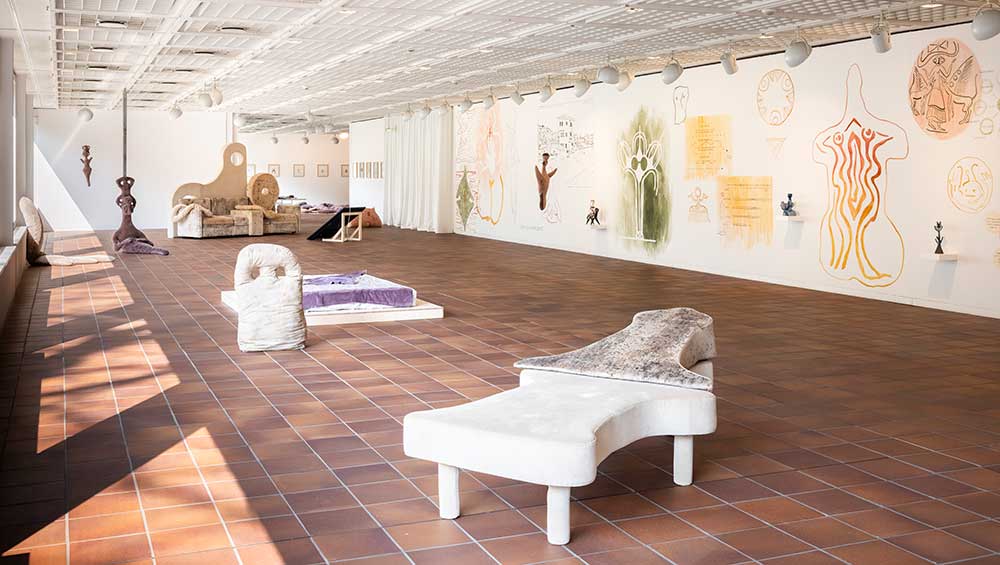
Valentina Karga: Well Beings, installation view, Kunstmuseum Bochum, Germany, 29 March – 31 August 2025. Photo courtesy Kunstmuseum Bochum.
Kunstmuseum Bochum, Germany
29 March – 31 August 2025
by WILL JENNINGS
There are fewer exhibitions more comfortable than Well Beings, the mixed-media installation comprising drawing, video, sculpture … and very relaxing soft furnishings, by the Berlin-based Greek artist and architect Valentina Karga. Where some artists might want the visitor to leave intellectually stimulated, eyes wide-opened to new ways of seeing the world, Karga wants those who experienced her Kunstmuseum Bochum presentation refreshed, relaxed, de-stressed, and ready to again step foot into the world and its issues.
At the centre of her eclectic arrangement of objects is the Hug Sofa (2023), Ikea furniture recycled and repurposed into a deeply relaxing, hybrid, creature-like settee. It invites the visitor to relax and sink into the natural-cotton upholstered foam, inviting it to take the weight and pressures of the world. But as soon as one reclines into the sofa, exhaling, there is an immediate, relentless reminder of why Karga has created such comfort.
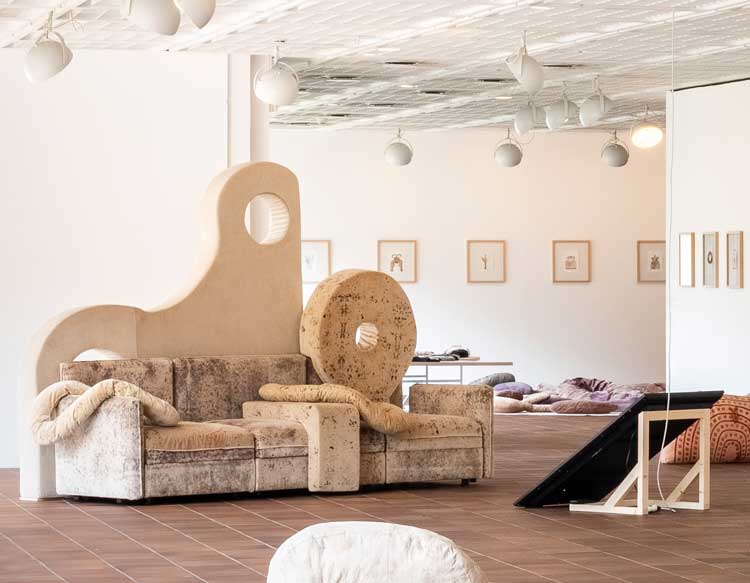
Hug Sofa, 2023, with Doomscroll, 2023, installation view, Valentina Karga: Well Beings, Kunstmuseum Bochum, Germany, 29 March – 31 August 2025. Photo courtesy Kunstmuseum Bochum.
In front of the sofa is Doomscroll (2023), an endless loop of disaster. Akin to swiping through social media updates, the vertical video feeds us flooding, fire, disaster, devastation, cataclysm and climate breakdown. It is presented as a social media platform and we are delivered updates from the Anthropocene: “The world has 9 years left to avert catastrophic disaster”; “The water destroyed farms and small businesses”; “It began burning on Friday and has now grown to 55,000 acres” among the scroll of messaging. But, interjected, are messages of coping: “Why cuddling is good for you: anxiety releasing products #climatechange #eco-anxiety”; “The pressure of weighted blankets puts your nervous system into ‘rest’ mode.”
“It reminds you that we are in a place of tension and conflict,” the artist says, while reclining into Hug Sofa: “Anxiety is an inhabited thing, you cannot think yourself out of it.” It is a weird dichotomy to sit in such welcoming comfort while transfixed to a screen of unrelenting anxiety, but it is reflective of our everyday lives – to at once be in our own private world, on our sofa, facing our screen, in relative comfort, but within it also trapped and anxious while waterboarded with images and news of global climate-related tragedy.
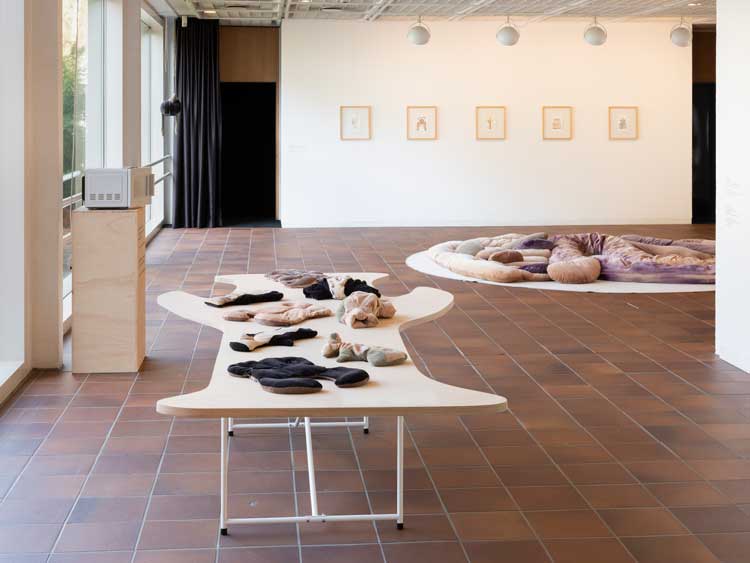
Valentina Karga: Well Beings, installation view, Kunstmuseum Bochum, Germany, 29 March – 31 August 2025. Photo courtesy Kunstmuseum Bochum.
The sofa, and many other gently interactive sculptures in Karga’s show, derive from commercial and therapeutic devices and strategies for coping with stress, anxiety and discomfort. These are artworks to help us, even if momentarily, feel a bit better – “a somatic approach to therapy,” Karga says, adding: “It’s not about cosiness, it’s about addressing the bodiliness of anxiety.”
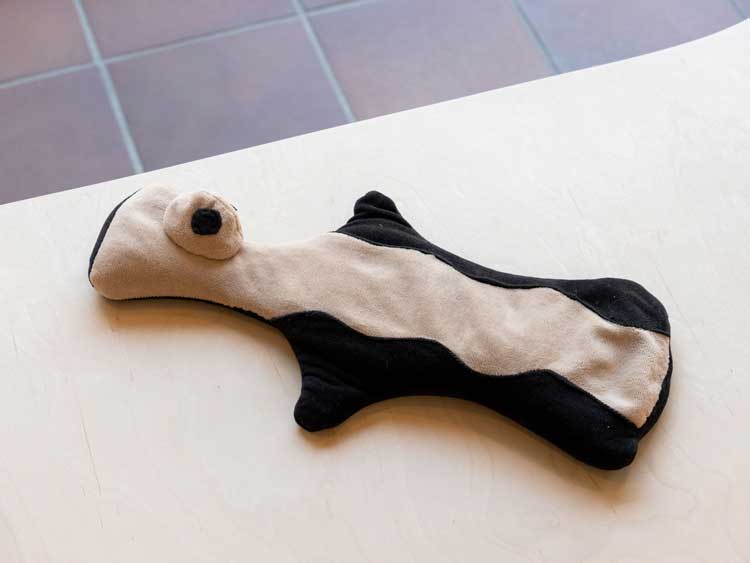
Valentina Karga: Well Beings, installation view, Kunstmuseum Bochum, Germany, 29 March – 31 August 2025. Photo courtesy Kunstmuseum Bochum.
Other soft-play sculptures also invite touch. Plush Prehistoric Posthumans (2023) comprises hand-sewn creatures like cuddly toys that adults can grasp. If soft toys help reduce anxiety and reinforce stability in kids, Karga tells us that it is OK to have these feelings as adults and to seek similar relief. Weighted Blanket (2023) is what it says, and it lays across a mattress on the floor awaiting a visitor to lay under it. The artist explains that such a blanket can offer the same feeling as a human hug, the gently exertion of pressure lowering the heart rate and calming nerves. Body Warmer Station (2023) is a table of assorted, smaller, hand-made gentle tools of relaxation. A microwave sits on a neighbouring plinth, each weighted shape can be heated up in it before rested across shoulders, arm or hand, or simply carried around the gallery as a form of comfort. Again, these look abstract in form, but are modelled on commercially sold products, albeit inflected with a sense of art history and humour.
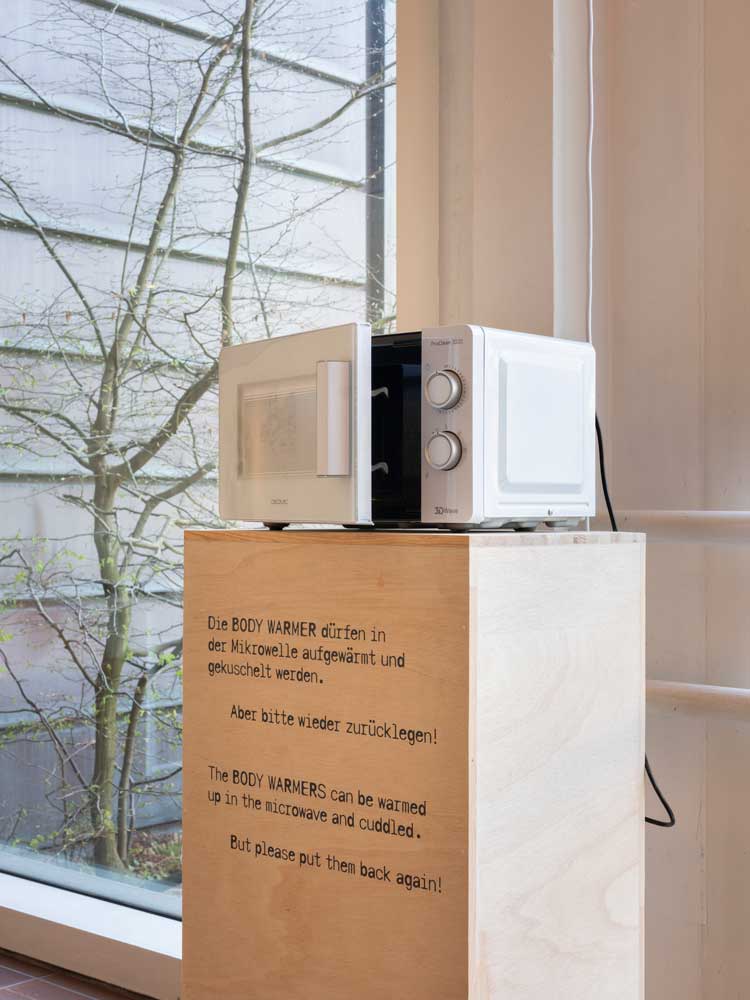
Valentina Karga: Well Beings, installation view, Kunstmuseum Bochum, Germany, 29 March – 31 August 2025. Photo courtesy Kunstmuseum Bochum.
A long mural and display of sculpture speak to Karga’s historical research, and a way of siting her haptic sculptures somewhere between capitalist tools of coping and artworld artefacts. Drawn in-situ, the 25-metre long Mural (2025) combines images of prehistoric idols with sketches of floods in Greece and Germany derived from media footage. On shelves are four sculptures from the museum collection, all made by Ida Vaculková, a Czech ceramicist and sculptor who drew inspiration from prehistory and archaic art.
Karga’s short documentary film on the Lithuanian archaeologist and anthropologist Marija Gimbutas (1921-94), researcher of Neolithic figurines, folklore, mythology and linguistics, helps pull all these diverse elements together. Gimbutas considered pre-bronze age Europe to be woman- and goddess-centred and read prehistoric sculptures as vessels for people to make sense of their surrounding world. In a profoundly patriarchal world, Karga has reintroduced these ancient figures into the gallery, inviting us to make sense of our world while also finding moments of care, tactility and comfort.
The forms of all the soft-sculptures that visitors are invited to hold, caress, sit on and get warmed by are drawn from these goddesses and clay objects as if searching for continuity to an ancient past at a time we, collectively, might feel alone, unmoored and drifting into an uncertain future. A wide, circular carpet contains even more of these abstracted, squeezable forms. Group Hug (2023) offers an arrangement of oversized, sinuously formed cushions, shapes derived from body parts of an ancient Mycenaean phi idol. It is an invitation for exhibition-goers to not stand back and admire the sculpture, but to dive on to the rug and combine themselves with it.
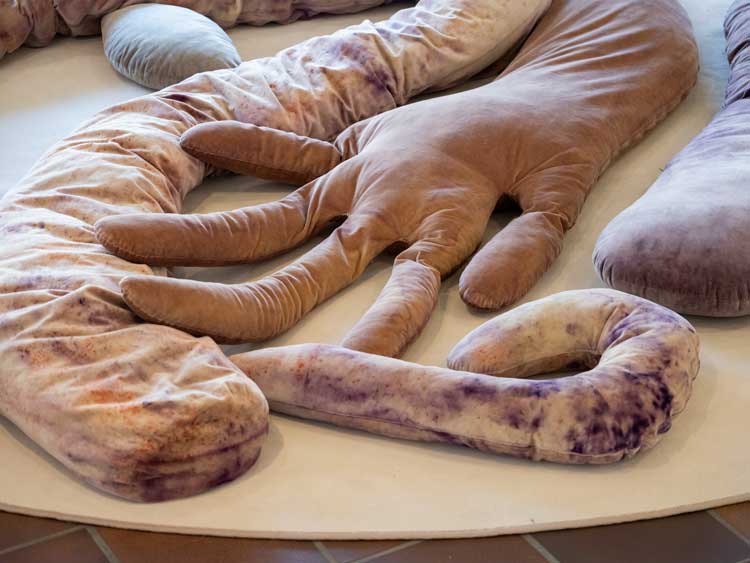
Valentina Karga: Well Beings, installation view, Kunstmuseum Bochum, Germany, 29 March – 31 August 2025. Photo courtesy Kunstmuseum Bochum.
“People like hugging, but not necessarily with people they don’t know,” Karga says. “This allows them to hug with others, but at a distance.” At the public opening, visitors were initially cautious, observing the unspoken, reserved rules of exhibitions not to touch the art but to observe it while gently stroking their chins in contemplation. After an hour, people had begun to stroke the works, then some began wearing them, and by the time the event closed Group Hug had indeed become dishevelled and disturbed by a few bodies. Perhaps they had been encouraged to collapse into the work after watching some of Adaption (2023), a semi-choreographed film Karga made in which students improvise a story of climate anxiety where they all end up entwined and coexisting.
No shortage of contemporary art exhibitions seek to remind us of the importance of valuing ecology, nature and the world of which we are custodians, but surely we are now at a point beyond reminding, one where everybody is profoundly aware of the problems if not yet existentially impacted by them. Perhaps the idea of using art to spread the word of climate disrepair is getting meaningless. Well Beings doesn’t simply tell us about the global situation, it assumes we already know all too well, but instead suggests ways in which we may mentally cope and survive while fires burn and waters surge. And, while sprawled with strangers among artworld softplay, it invites openings where we may share anxieties and fears with others, or if preferred to have a moment to oneself to contemplate, but to acknowledge it is real.